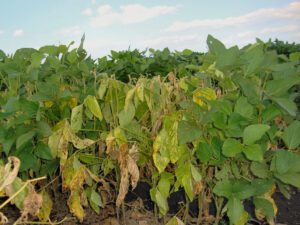In Part 1, we talked about a few common pests you might be seeing in your soybean fields. Now we’ll cover early season diseases you might find in your soybean fields with part two of our early season soybean concern series.
Damping off is the rotting and death of seeds and seedlings and the symptoms can show in soybean plants prior to or just after emergence. Pathogens that can cause damping off, such as Pythium, Fusarium, Phytophthora, and Rhizoctonia are generally favored by wet soils following planting and for most of the country we certainly have had just that this year.
Fusarium
Infection is caused by a complex of different species that prefer a variety of conditions; some prefer warm and dry soils, while others prefer cool and wet soils. Some species attack corn, wheat and other host plants. Fusarium in soy causes light- to dark-brown lesions on soybean roots that may spread over much of the root system. May also attack the taproot and promote adventitious root growth near the soil surface, and is possible you may see degradation of lateral roots, but this usually does not cause seed rot.

Soybean seedlings with damping off symptoms due to Pythium seedling blight
Pythium
Prefers cold soil temperatures of <59°F (15°C) and may be the first soybean disease found in a growing season. High-residue fields and heavy or compacted soils are at higher risk because of cooler, wetter conditions. The pathogen may attack seeds before or after germination; seeds killed before germination are soft and rotted with soil adhering to them. Plants may be killed by “damping off” before or after emergence. On infected plants, the hypocotyl becomes narrow and is commonly “pinched off” by the disease.
Rhizoctonia Root and Stem Rot
More common in wet soils or moderately wet soils where germination is slow, or emergence is delayed. Infection is characterized by a shrunken, reddish-brown lesion on the hypocotyl at or near the soil line. This normally appears as the weather becomes warm, around 81°F (27°C); more often seen in late-planted soybean fields. Rhizoc causes loss of seedlings (damping-off) in small patches or within rows but is usually restricted to the seedling stage.

Soybeans wilting due to Phytophthora root and stem rot
Phytophthora Root and Stem Rot
Mostly associated with wet soil conditions, commonly occurs on heavy, poorly drained or compacted soils. The seedling blight phase occurs at emergence or soon after and is characterized by rapid decay, wilting, and plant death. The root and stem rot phase can occur later in development. Symptoms begin in the roots and may spread to the stem. Dark-brown to red-brown lesions that may progress up the stem are a key diagnostic feature of the stem rot phase. These diseased tissues quickly become soft/water-soaked and wilting and plant death may soon follow, especially during stress periods.
In Part 3 we will discuss some options to put up a strong battle plan against many of these insects and diseases. Coming soon.